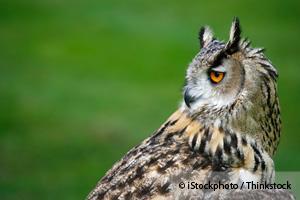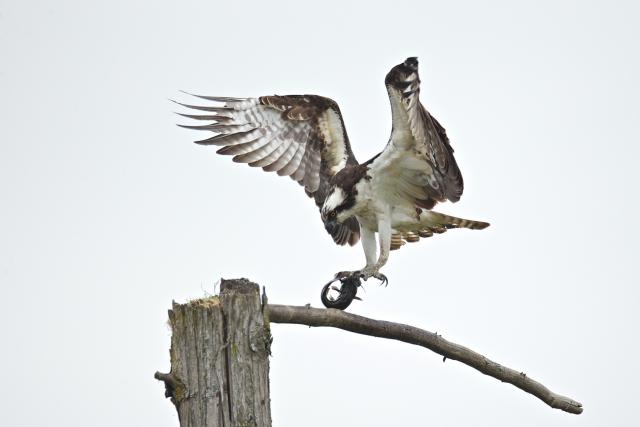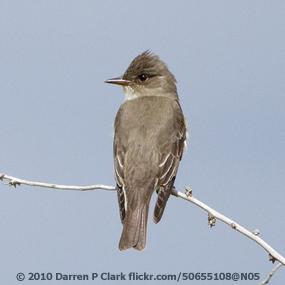For “Winged Wednesday”:
Chilean Woodstar


"In one of the driest deserts of the world, a tiny hummingbird with a long forked tail and violet throat guards his territory among some chañar bushes along a wash surrounded by lifeless expanses of sand and rock. This Chilean Woodstar continues to hang on, but for how long?
The Chilean Woodstar was once found in desert river valleys of northern Chile and southern Peru, but has only been seen in remnant habitat patches in three Chilean valleys during the last decade. During this time, the population declined by more than 80 percent, from at least 1,500 birds in 2003 to roughly 400 birds in 2012.
This dramatic decline led ABC and partner group AvesChile to petition the bird’s uplisting from Endangered to Critically Endangered by the International Union for Conservation of Nature (IUCN). The woodstar’s decline started in the 1960s when pesticides (now discontinued) to control fruit flies were widely used. In the 1970s, the closely related Peruvian Sheartail, which competes and hybridizes with the Chilean Woodstar, expanded its range from Peru, possibly assisted by expanding agriculture and other human-related changes to the landscape.
Most of the Chilean Woodstar’s natural habitat has been converted to agriculture or heavily degraded, and the species now relies on a mix of native and non-native plants for feeding and nesting. ABC is currently seeking funding to expand our work with AvesChile to establish a network of small reserves where we can restore and manage habitat for the Chilean Woodstar, experiment with sheartail removal, conduct public outreach to reduce pesticide usage — and ultimately prevent the extinction of this species.”
![]() Help this and other birds and their habitats by supporting ABC. Can't click the link? Copy and paste this URL: https://www.abcbirds.org/membership/donate.cfm
Help this and other birds and their habitats by supporting ABC. Can't click the link? Copy and paste this URL: https://www.abcbirds.org/membership/donate.cfm
Photo by Jorge Herreros; Range Map by NatureServe
______
Fourth of July Beachgoers Asked to "Fish, Swim, and Play from 50 Yards Away"

As millions of vacationing Americans head to their nearest beach destination for a long weekend of surf and sun, one of the nation’s leading bird conservation organizations – American Bird Conservancy (ABC) – is urging beachgoers to be mindful of the many beach-nesting birds that will be tending to young birds and perhaps a few remaining eggs.
“People visiting the beaches are often unaware of the many species of birds that nest in the sands near where they are swimming, fishing, and recreating. As a result, nests can accidentally get trampled, destroyed, or abandoned,” said ABC’s Kacy Ray, Gulf Beach-Nesting Bird Conservation Project Officer.
"The best thing for beachgoers to do is to avoid getting close to areas where larger congregations of birds are gathered, and to always respect areas that are roped off or marked with signs designating an area that is used by nesting birds,” says Ray. “The habitat for these birds is diminishing every year due to beach development, erosion, and ever-increasing recreational use, so the birds can really use any break we can give them. They have no other place to go,” Ray said.
Ray points out that it can be difficult for both the year-round resident and the casual vacationer to see the difference between a bird that is simply sitting on the sand and one that is tending eggs or a nest or young.
You know you’ve entered a nesting area when large groups or individual birds vocalize loudly, dive-bomb your head, or feign injury to lead you away from their nests. If this happens, back away and share the beach so the birds can successfully rear their young.
Ray said that there are special concerns for different regions of the country:” More at: http://www.abcbirds.org/newsandreports/releases/130613.html
______
Climate change killing puffin chicks.
“Earlier this month, scientists reported puffins are just the most recent species revealing the dangers that global warming brings for our wildlife.

Let President Obama know that you support taking critical action to help protect puffins and many more wildlife from climate change. " at: https://online.nwf.org/site/Advocacy?cmd=display&page=UserAction&id=1763
______
Tricolored blackbirds are disappearing faster than thought
“The tricolored blackbird was once among the most common birds in California, with vast colonies of the colorful and highly gregarious species nesting and foraging year-round in marshes and rangelands.
Scientists have been worried about a decline in tricolored blackbirds for years now, and the latest statewide surveys show that things are worse than they thought. The entire population dropped from an estimated 400,000 birds in 2008 to roughly 258,000 in 2011.” More at: http://ucdaviscaes.wordpress.com/2013/06/24/tricolored-blackbirds-are-disappearing-faster-than-thought/
_______
How Owls Spin Their Heads Around

“Owls don't need eyes in the back of their heads to see what's behind them — they can just swivel their heads all the way around. In fact, many owl species, such as the barred owl, can rotate their heads 270 degrees in each direction, which means they can look to the left by rotating all the way to the right, or vice versa.
 But how do they do it without severing their arteries or preventing blood from reaching the brain? An illustrator and a physician at the Johns Hopkins University School of Medicine teamed up to find out.
But how do they do it without severing their arteries or preventing blood from reaching the brain? An illustrator and a physician at the Johns Hopkins University School of Medicine teamed up to find out.
"Until now, brain imaging specialists like me who deal with human injuries caused by trauma to arteries in the head and neck have always been puzzled as to why rapid, twisting head movements did not leave thousands of owls lying dead on the forest floor from stroke," said study author Dr. Philippe Gailloud, in a statement from the university.” More at: http://news.discovery.com/animals/pets/how-owls-spin-heads-around-130201.htm
______
Osprey with Fish (4 of 11)
“The Osprey is the only North American raptor to eat almost exclusively fish, (piscivorous), and what adaptations do they have to handle their slippery prey? To help grip its prey, the talons of the Osprey have barbed pads and a reversible outer toe with two (very sharp) talons in front and two in back--unusual amongst hawks. Ospreys will also carry fish headfirst to minimize wind resistance.
Only a summer visitor in much of its North American range, Ospreys winter in coastal California, Texas, and Florida to as far south as Argentina.
Gregg Thompson photographed this Osprey capturing and eating a large fish. Check out image 7 to see the nictitating membrane the Osprey uses to protect its eye; images 8 and above show how far the Osprey turns its head to tear off a piece.” More at: http://birdnote.org/photo/2013/06/osprey-fish-4-11 By Gregg Thompson
______
BirdNote Weekly Preview: Penguins, Owls, and Flycatchers!
Upcoming Shows:
African Penguin
SUNDAY
The Greatest
Bird Rescue Ever
by Bob Sundstrom
LISTEN NOW ►
American Crow
MONDAY
Crow Parents,
Fearless Defenders
by Ellen Blackstone
LISTEN NOW ►
European Starling
TUESDAY
Begging Sounds
And Postures
by Frances Wood
LISTEN NOW ►
Great Horned Owl
WEDNESDAY
Voices and Vocabularies - Great Horned Owls
by Bob Sundstrom
LISTEN NOW ►
Canvasback
THURSDAY
Detroit River International Wildlife Refuge
by Bob Sundstrom
LISTEN NOW ►
American Coot
FRIDAY
Eavesdropping on Babies
by Chris Peterson
LISTEN NOW ►
Olive-sided Flycatcher
SATURDAY
Olive-Sided Flycatcher - Preserving a Unique Voice
by Bob Sundstrom
______
And our winged friends the bees:
More Than 25,000 Bees Die in Oregon
More than 25,000 bees and other insects were found dead at a Target, Wilsonville, OR parking lot this week (AP Photo)
“The mystery of why thousands of bees fell from the sky has been solved, according to the Oregon Department of Agriculture. On Friday, they determined the bees were killed by an insecticide called Safari used to kill aphids. The trees where the insecticide was used are being netted to protect any surviving bees that might wander into the area.” More at: http://abcnews.go.com/blogs/headlines/2013/06/more-than-25000-bees-die-in-oregon/
_______
On This Day:
President John Tyler weds his second wife, Jun 26, 1844:
“Fifty-four year old widower President John Tyler marries 21-year-old Julia Gardiner on this day in 1844. It was his second marriage. At the time, Julia was the youngest first lady in history. Tyler had wooed Julia from the time she was 19, but it took a tragedy and a narrow escape from death for her to accept him.
Earlier that year, Tyler and an entourage, including wealthy New Yorker David Gardiner and his daughter Julia, had cruised the Potomac on board the new steam frigate U.S.S. Princeton. During the voyage, the Princeton fired off its new cannons in salute as it sailed past George Washington's former home at Mt. Vernon. At the time, Tyler was below deck raising a toast. The cannon exploded on its third volley, killing Julia's father and several others, including members of Tyler's cabinet. Tyler rushed up to the top deck just in time to catch Julia as she fainted at the news of her father's death. After the ship docked, Tyler whisked Julia off to safety in his arms. Thereafter, her admiration for him developed into love and, in 1844, they were married. Julia Gardiner Tyler reportedly insisted that "Hail to the Chief" be played at Tyler's entrance to every official event, thus establishing a presidential tradition. One of her constant companions was a greyhound given to her by her husband.
Tyler's first wife had been Letitia Christian, with whom he had eight children (one died in infancy). She died of a stroke in 1842. He and Julia had seven children together bringing his total to 15; Tyler holds the record for the most children sired (legitimately, at least) by a president. He was a devoted husband and doting father to his rather large brood of children from both marriages. The extended nature of his family, though, along with his penchant for overspending, left Tyler perpetually in debt. When he died of a stroke in 1862, he left Julia practically penniless. She died in 1889 in the same Richmond, Virginia, hotel room in which her husband had died 27 years earlier.”
---------
AN AMAZING FACT: “There has been one United States president who, when he died, was no longer a citizen of the United States. It was the country’s tenth president— John Tyler.
John Tyler served in office from 1841 to 1845. But more than being an American, Tyler was a Virginian. And so when Virginia, along with the other southern states, seceded from the union, Tyler stayed true to his home state and joined them, renouncing his U.S. citizenship.
Tyler had actually served as the chair of the Virginia Peace Convention, which was held in 1861 in Washington, D.C. It was an effort to prevent a civil war. When no compromise was achieved, however, he viewed secession as the only option and joined Virginia and the other states in abandoning their citizenship.
From there, he was elected to the House of Representatives of the Confederate Congress, but it was a position he would never fill. He died on January 18, 1862, before ever serving one day in office. And thus, he is the only president in the history of the United States to die as a former citizen.”
_______
Congress approves Federal Highway Act, Jun 26, 1956:
“On this day in 1956, the U.S. Congress approves the Federal Highway Act, which allocates more than $30 billion for the construction of some 41,000 miles of interstate highways; it will be the largest public construction project in U.S. history to that date.
Highway construction began almost immediately, employing tens of thousands of workers and billions of tons of gravel and asphalt. The system fueled a surge in the interstate trucking industry, which soon pushed aside the railroads to gain the lion's share of the domestic shipping market. Interstate highway construction also fostered the growth of roadside businesses such as restaurants (often fast-food chains), hotels and amusement parks. By the 1960s, an estimated one in seven Americans was employed directly or indirectly by the automobile industry, and America had become a nation of drivers.
Legislation has extended the Interstate Highway Revenue Act three times, and it is remembered by many historians as Eisenhower's greatest domestic achievement. On the other side of the coin, critics of the system have pointed to its less positive effects, including the loss of productive farmland and the demise of small businesses and towns in more isolated parts of the country.”
_______
Yesterday:
Misty and I went to get Jay, and had our walk down there. I had a special job for Jay!
We are still working on the fence along the walkway to my back yard. One of the short fence posts that replaced one of the tall ones, needed to be pulled up, and replaced with another one.
The other day, Jay sawed off the tops of the installed fence posts, even when I asked him to stop. To my thinking, that should have waited until it was all finished when we would pop a line on the whole fence and cut it level. Jay had cut one post too short, and it was the most important post at the end, as it has a gate and another fence coming off it. I wanted Jay to fix it, as it was his fault. He hates fence-post digging, but pulled the post out, and started to clean the dirt out of the hole.
I walked around the corner to help Ray screw the base on the outside table, and when I came back, there was Jay with a post sticking out of the hole. I asked him where is the short post, as it looked like the same one to me. I put a pencil mark at ground level and pulled the post out. There was no way it was in deep enough at one foot. He had just put dirt in the hole to make the post taller. It was the same post (which I already knew by a knot in it), and not only that, it was crooked in the hole.
Now, you can’t very well hang a gate on a square post that isn’t square with the rest of the fence, it just puts the whole thing in a bind. He realized that I wasn’t going to put up with any of his short cuts, and that I probably wouldn’t pay him until he did it right, so he resigned himself to squaring up the hole. When he had finished, just to check on him, I put a pencil mark on the longer post and pulled up it up to see how deep it was. This time it was a good 2’ in the ground, so I leveled it while he back-filled the hole.
So why do I use Jay around here? Several reasons. He is the only person around here who is available, willing to work, and can proficiently use a circular saw. Ray can use one, but not like Jay, as Jay used to frame houses. (My little Skill saw bit the dust, and my other ones are too heavy for me to use, so I just use my chop saw.) Other reasons; he likes to work in the mornings as it keeps him sober and out of his mother’s way. Plus, he works cheap.
My wonderful Terry pictured. RIP
Nila, my foster cat, doesn’t consider my bathroom window the best seat in the house. All the other cats that have been here just love it.

Even though Midnight has been vaccinated and checked out by the vet, my SPCA boss doesn’t want Nila and Midnight to be together. Nila is all checked out ready to go back to the Habitat at Petco, whereas Midnight is staying at someone’s home until her kittens are weaned.
Keeping them apart is going to be a hard four days.


























No comments:
Post a Comment